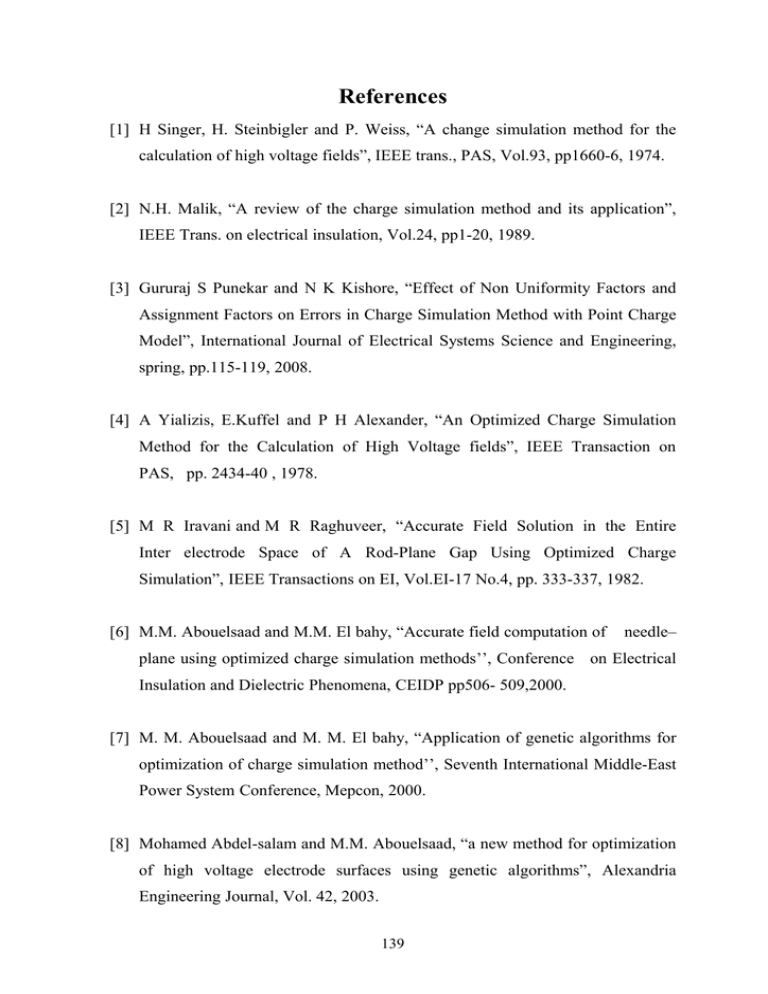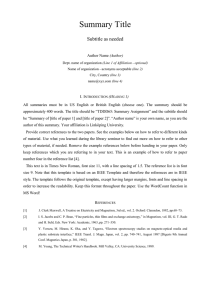References
advertisement

References [1] H Singer, H. Steinbigler and P. Weiss, “A change simulation method for the calculation of high voltage fields”, IEEE trans., PAS, Vol.93, pp1660-6, 1974. [2] N.H. Malik, “A review of the charge simulation method and its application”, IEEE Trans. on electrical insulation, Vol.24, pp1-20, 1989. [3] Gururaj S Punekar and N K Kishore, “Effect of Non Uniformity Factors and Assignment Factors on Errors in Charge Simulation Method with Point Charge Model”, International Journal of Electrical Systems Science and Engineering, spring, pp.115-119, 2008. [4] A Yializis, E.Kuffel and P H Alexander, “An Optimized Charge Simulation Method for the Calculation of High Voltage fields”, IEEE Transaction on PAS, pp. 2434-40 , 1978. [5] M R Iravani and M R Raghuveer, “Accurate Field Solution in the Entire Inter electrode Space of A Rod-Plane Gap Using Optimized Charge Simulation”, IEEE Transactions on EI, Vol.EI-17 No.4, pp. 333-337, 1982. [6] M.M. Abouelsaad and M.M. El bahy, “Accurate field computation of needle– plane using optimized charge simulation methods‟‟, Conference on Electrical Insulation and Dielectric Phenomena, CEIDP pp506- 509,2000. [7] M. M. Abouelsaad and M. M. El bahy, “Application of genetic algorithms for optimization of charge simulation method‟‟, Seventh International Middle-East Power System Conference, Mepcon, 2000. [8] Mohamed Abdel-salam and M.M. Abouelsaad, “a new method for optimization of high voltage electrode surfaces using genetic algorithms”, Alexandria Engineering Journal, Vol. 42, 2003. 139 [9] Gururaj S Punekar, N K Kishore, and H S Y Shastry, “Optimized Charge Simulation Models of Horizontal Sphere Gaps”, Annual Report Conference on Electrical Insulation and Dielectric Phenomena, IEEE, 2006. [10] Nishimura, K.Nishimori and N. Ishihara, “Determining the arrangement of fictitious charges in charge simulation method using genetic algorithms”, J. Electrostatics, Vol. 49, pp. 95-105, 2000. [11] Nishimura, K.Nishimori and N. Ishihara, “Automatic arrangement of fictitious charges and contour points in charge simulation method for polar coordinate system”, J. Electrostatics, Vol. 51-52, pp. 618-624, 2001. [12] Nishimura, K.Nishimori and N. Ishihara, “Automatic arrangement of fictitious charges and contour points in charge simulation method for two spherical electrodes”, J. Electrostatics, Vol. 57, pp. 337-346, 2003. [13] Nishimura and K.Nishimori, “Arrangement of fictitious charges and contour points in charge simulation method for electrodes with 3-D asymmetrical structure by immune algorithm”, J. Electrostatics, Vol. 57, pp. 743–748, 2005. [14] S.Chakravorti and P.K. Mukherjee, “Application of Artificial Neural Networks for Optimization of Electrode Contour”, IEEE Transactions on Dielectrics and Electrical Insulation, Vol. 1, No. 2, 1994. [15] P.K. Mukherjee, C. Trinitis and H. Steinbigler, “Optimization of HV Electrode Systems by Neural Networks using a New Learning Programming”, IEEE Transactions on Dielectrics and Electrical Insulation, Vol. 3, No. 6 , 1996. [16] H. Okubo, T. Otsuka, K. Kato, N. Hayakawa and M. hikita, “Electric Field Optimization of High Voltage Electrode Based on Neural Networks”, IEEE Transactions on Power Systems, Vol. 12, No. 4, 1997. 140 [17] B. Sareni, L. Kriihenbuhl and D. Muller, “Niching Genetic Algorithms for Optimization in Electromagnetics”, IEEE Transactions on Magnetics, Vol. 34, No 5, 1998. [18] Chen Xudong, Qian Jingen, Ni Guangzheng, Yang Shiyou, and Zhang Mingliu, “An Improved Genetic Algorithm for Global Optimization of Electromagnetic Problems”, IEEE Transactions on Magnetics, Vol. 37, NO. 5, 2001. [19] Xiaoming Liu, Yundong Cao, and Erzhi Wang, “Numerical Simulation of Electric Field With Open Boundary Using Intelligent Optimum Charge Simulation Method”, IEEE Transactions on Magnetics, Vol. 42, NO. 4, 2006. [20] Wen-Shiush Chen , Hong-Tzer Yang and Hong-Yu Huang, “Optimal Design of Support Insulators Using Hashing Integrated Genetic Algorithm and Optimized Charge Simulation Method”, IEEE Transactions on Dielectrics and Electrical Insulation Vol. 15, No. 2, 2008. [21] M S Naidu, V Kamaraju, “High Voltage Engineering‟‟, Tata McGraw Hill, 2004. [22] M. Abdel-salam, H. Anis, A. El-Morshedy and R. Radwan, “high voltage engineering theory and practice ‟‟, second edition revised and expanded, Marcel Dekker Inc., New York, 2000. [23] D. Goldberg, “Genetic algorithms in search, optimization, and machine learning ‟‟, Addison-Wesley, 1989. [24] Randy L. Haupt and Douglas H. Werner, “Genetic Algorithms in Electromagnetics” , John Wiley & Sons, 2007. 141 [25] S.N.Sivanandam and S.N.Deepa, “Introduction to genetic algorithms”, Springer, 2008. [26] Dr. Franz Rothlauf, “Representations for Genetic and Evolutionary Algorithms ”, Springer, 2006. [27] Randy L.Haupt and Sue Ellen Haupt, “practical genetic algorithms”, John Wiley & Sons, 2004. [28] Sumathi, T. Hamsapriya and P. Surekha, “Evolutionary Intelligence an Introduction to Theory and Applications with Matlab ”, Springer, 2008. [29] Zbigniew michalewicz, “Genetic algorithms +data structures = Evolution Programs ” third, revised and extended edition, Springer, 1996. [30] Mitsuo Gen and Runwei Cheng, “Genetic Algorithms and Engineering Optimization”, John Wiley & Sons, 2000. [31] Murashima and H. Kuhara, “An approximate method to solve two-dimensional Laplace‟s equation by means of superposition of Green‟s functions on a Riemann surfaces”, Journal of Information Processing, pp127–139, 1980. [32] Karageorghis A. and Fairweather G., “The method of fundamental solutions for the numerical solution of the biharmonic equation”, J. Comput. Phys., 69, pp 434-459, 1987. [33] Poullikkas, A. Karageorghis and G. Georgiou, “Methods of fundamental solutions for harmonic and biharmonic boundary value problems”, Comp. M.; vol. 21, pp. 416-423,1998. 142 [34] P. Mitica and Y.F. Rashedb, “Convergence and stability of the method of meshless fundamental solutions using an array of randomly distributed sources”, Eng. Anal. Bound. Eelem., Vol. 28, pp. 143-153 , 2004. [35] J. Wang and J.D. Lavers, “On the determination of the Locations for the Virtual Sources in the Method of Fundamental Solutions for Eddy Current Problems”, IEEE T Magn., Vol. 31, No. 6, pp. 3512- 3514, 1995. [36] Yong Wang and Yoram Rudy, “Application of the Method of Fundamental Solutions to Potential-based Inverse Electrocardiography”, Ann Biomed Eng., pp 1272–1288, 2006. [37] Y. C. Hon and T. Wel, “A fundamental solution method for inverse heat conduction problem”, China , Project No. City U. 1178/02P, 2004. [38] Karageorghis and D. Lesnic, “The Method of Fundamental Solutions for Steady-State Heat Conduction in Nonlinear Materials”, Comput. Phys., Vol. 4, No. 4, pp. 911-928, 2008. [39] Chia-Ming Fan, Der-Liang Young and Chia-Lin Chiu, “Method of Fundamental Solutions with external source the eigenfrequencies of waveguides ”, Journal of Marine Science and Technology, Vol. 17, No. 3, pp. 164-172 , 2009. [40] H. Jopek and J.A. Kołodziej, “Application of genetic algorithms for optimal positions of source points in method of fundamental solutions‟‟, Proceedings of Lsame, 2008. [41] A.P. Cisilino and B. Sensale, “Optimal Placement of the Source Points for Singular Problems in the Method of the Fundamental Solutions‟‟, Electronic Journal of Boundary Elements, Vol. BETEQ 2001, No. 3, pp. 368-376 , 2002. 143 [42] N.N. Lebedev and I.P. Skal‟skaya, “Force acting on a conducting sphere in the field of a parallel plate condenser”, Soviet Phys.-Tech. Phys. 7, pp. 268–270, 1962. [43] N.J. Felici, “Forces et charges de petits objets en contact avec une 61ectrode affectee d'un champ electrique ”, Rev. Gen. Elec., pp. 1145 116075 , 1966. [44] T.B. Jones, “Electromechanics of Particles”, Cambridge University Press, New York, pp. 183–185, 1995. [45] Alberto T. Perez, “Charge and force on a conducting sphere between two parallel electrodes”, Journal of Electrostatics 56, 199–217, 2002. [46] Smith, J. Carey, R. Forrest and S. Silva, “Effect of aspect ratio and anode location on the field emission properties of a single tip based emitter”, Journal of Vacuum Science and Technology B 23, pp. 632–635, 2005. [47] N.N. Lebedev and I.P. Skal‟skaya, “Force acting on a conducting sphere in the field of a parallel plate condenser”, Soviet Phys.-Tech. Phys. 7, pp. 268–270, 1962. [48] M.H. Davis, “ Electrostatic field and force on a dielectric sphere near a conducting plane–a note on the application of electrostatic theory to water droplets ” Am. J. Phys. 37, pp. 26–29, 1969. [49] Hara and M. Akazaki, “ A method for prediction of gaseous discharge threshold voltage in the presence of conducting particles ”, J. Electrostatics, pp. 223 -239, 1976. 144 [50] Anis and K.D. Srivastava, “Free conducting particles in compressed gas insulation” IEEE Trans. Electrical Insulation, pp.327-338, 1981. [51] Cai Xiaoping, “The electrostatic problem of a dielectric sphere near a plane”. J. Electrostatics, 201, 1987. [52] Soria, A. Ramos and A. T. Perez, “The charged bouncing ball: An experimental model for period-doubling bifurcation”, Europhys. Lett.37, no. 8, 541-546 ,1997. [53] S. Birlasekaran, “The measurement of charge on single particles in transformer oil”, IEEE Trans. Electr. Insulat. , pp.1094–1103, 1991. [54] S. Birlasekaran, “The movement of a conductive particle in transformer oil in a.c. fields”, IEEE Trans. Electrical Insulation, pp. 9-17, 1993. [55] A. Khayari, A.T. Perez and F.J. Garcia, “ Castellanos, Dynamics and deformation of a drop in a DC electric field”, IEEE Electr. Insulat. Dielectric Phenom., USA, Albuquerque, pp. 682–685, 2003. [56] Denegri, G. B., G. Liberti, G. Molinari, and A. Viviani, “Field-enhanced motion of impurity particles in fluid dielectrics”, IEEE Trans. Electr. Insul. 12 , 114–124, 1977. [57] Bozzoa, G. Calcia, P. Girdinioa, P. Molfinoa and A. Viviania, “ First results of computer aided identification of model parameters for field-enhanced impurity motion in dielectric liquids ”, IEEE International Symposium on Electrical Insulation , pp. 141–144, 1982. [58] Zehui Jiang, Zhiying Shena and Kunquan Lub, “Dipole images in conductingparticle chains ”, J. Electrostat. 53 , pp.53–65, 2001. 145 [59] Ioannis P Stavroulakis and Stepan A Tersian “Partial differential equations” Scond Edition, 2003. [60] Lawrence C. Evans, “Partial differential equations ” graduated studies in mathematics, Vol. 19, American mathematical society, 1997. [61] H.F. Weinberger “A first course in Partial differential equations with complex variables and transform methods” Dover Publications, INC., New York, 1995. 146


